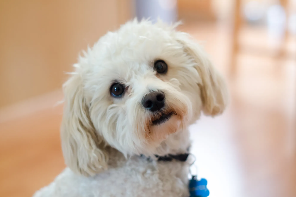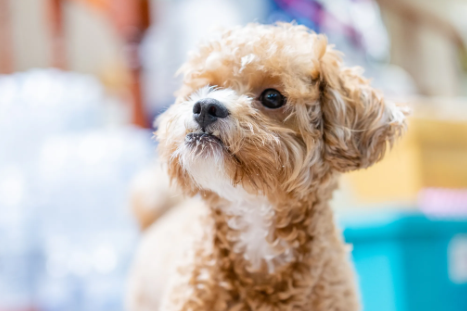

The Maltipoo is a cross between a Maltese and a Poodle, another hybrid breed in the recently popular category of doodle dogs. Alert and active, the Maltese Poodle mix is known for their adorable appearance, friendly disposition, and hypoallergenic coat. These small dogs come in various colors, from creamy white and apricot to chocolate and silver. With their intelligent and trainable nature, the Maltese Poodle thrives in active homes where they can be the center of attention.
The Maltipoo’s easygoing and affectionate temperament makes them an ideal companion for all types of households. This popular Poodle mix loves social interaction and strongly attaches to their human companions. However, they aren’t very independent and can be prone to separation anxiety if left alone for long periods. As with other breeds, early socialization is essential.

When considering a Maltipoo, it’s important to prioritize adoption from rescue organizations or shelters to provide a loving home to a dog in need. However, if you’re searching for Maltipoo puppies and decide to purchase one, it’s crucial to choose a reputable breeder. Conduct thorough research to ensure that the breeder follows ethical practices and prioritizes the well-being of their dogs. Reputable Maltipoo breeders prioritize the health and temperament of their dogs. They also conduct necessary health screenings and provide a nurturing environment for the puppies.

Contents
Quick Facts
- Origin: United States. The goal was to combine the Poodle’s hypoallergenic coat and intelligence with the Maltese’s charm and compact size.
- Breed Group: Hybrid (Designer)
- Size: A full-grown Maltipoo weighs 5-15 pounds (2.3-6.8 kg), while the Teacup Maltipoo weighs 3 to 5 lbs.
- Lifespan: Maltipoo lifespan ranges from 10-15 years
- Coat: Maltipoos can have a variety of coat types, including straight, wavy, or curly. They often have low-shedding or hypoallergenic coats, which can vary depending on the generation of the cross.
- Temperament: Maltipoos are known for being affectionate, friendly, and sociable. They often form strong bonds with their families and can get along well with children and other pets.
- Exercise Needs: The Maltipoo dog has moderate exercise requirements. Regular playtime, walks, and mental stimulation are important for their well-being.
- Training: Maltipoos are usually intelligent and eager to please, making them trainable. Positive reinforcement methods work well with them.
- Grooming: Grooming needs depend on the coat type. Regular brushing and occasional professional grooming help keep their coat in good condition.
- Health: While generally healthy, Maltipoo health issues can be inherited from both parent breeds. Responsible breeding practices, regular veterinary care, and a balanced diet are important for their overall health.
- The Maltese Poodle is a favorite of celebrities, including Rihanna, Blake Lively, and Miley Cyrus.
Maltipoo Overview
Maltipoos are a popular cross between the Maltese and the Toy or Miniature Poodle. True to their parent breeds, They are affectionate and gentle. They make super companions for empty-nesters and are excellent therapy dogs. Cross breeds such as the Maltipoo are often referred to as designer dogs rather than mixed breeds because they’re purposely bred and combine two known breeds.
Because Poodles and Maltese are considered non-shedders, people who breed Maltipoos hope to end up with hypoallergenic dogs. If you’re allergic, however, it’s important to know a little something about pet allergies before you run out to get a Maltipoo.
All dogs produce dander (dead skin flakes) and saliva, which carry allergens. And allergies can build over time. You may not react to a dog when you first meet him but develop an allergy after living with him for days, weeks, or even months. Spend lots of time with several different Maltipoos to see how you’ll react. If you decide that a Maltipoo is for you, you’ll find that he’s an active, feisty, fun-loving dog.
He enjoys life, and his perfect day includes playing dog games, walking, and racing through the house. Maltipoos can be a good choice for first-time or timid owners. They’re easy to train and learn quickly. They also do well in homes with elderly people or with older children who can handle them carefully.
They enjoy long cuddles and are sensitive to their people’s wants and needs. Maltipoos can adapt to any kind of home, from an apartment to a house. No matter their housing, they love being with their people and should live indoors with their human families, never outside or in kennels. They’re not recommended for homes where they’ll be left alone for long periods. Maltipoos can be barkers and will alert you to everything happening. You may need to work hard to teach them to discriminate between what’s important to bark at and what’s not. Maltipoos are fun-loving, happy dogs who’ve stolen many hearts. For those who appreciate their cuddly appeal and can give them the companionship they need, they can make an ideal pet.

Maltipoo Highlights
Adorable Crossbreed: The Maltipoo is a charming and popular crossbreed that combines the best traits of the Maltese and the Poodle.
Hypoallergenic Coat: Known for their low-shedding and hypoallergenic coat, Maltipoos are often a good choice for individuals with allergies.
Compact Size: Maltipoos are small-sized dogs, making them well-suited for apartment living and households with limited space.
Companion Nature: These dogs thrive on companionship and are known for forming strong bonds with their families. They are affectionate and enjoy being around people.
Intelligence: Maltipoos inherit intelligence from both parent breeds, making them quick learners and adaptable to various training commands.
Playful and Social: Maltipoos have a playful and friendly demeanor, making them enjoyable companions for families, singles, and seniors alike.
Moderate Exercise Needs: While they have energy to expend, Maltipoos don’t require extensive exercise. Regular walks and play sessions are usually enough to keep them content.
Training Potential: Due to their intelligence and eagerness to please, Maltipoos are often successful in obedience training and can learn tricks quickly.
Grooming: Their coat requires regular grooming to prevent matting, but their low-shedding nature reduces the amount of hair in the environment.
Long Lifespan: Maltipoos enjoy a relatively long lifespan for a small breed, often living between 10 to 15 years.

Maltipoo Size
The Maltipoo varies in size, depending on whether the Poodle parent was a Toy or Miniature. Generally, Maltipoos stand 8 to 14 inches tall and weigh 5 to 20 pounds.
Maltipoo Personality
This is an intelligent, affectionate, fun-loving dog who generally gets along well with everyone he meets. Gentle and devoted, Maltipoos enjoy spending their days perched on their owner’s laps or walking beside them. They can also be active and feisty and enjoy a good play session just as much as they relish a long cuddle.
They’re alert and make excellent alarm dogs, but don’t count on them to provide protection. Like all dogs, Maltipoos need early socialization — exposure to many different people, sights, sounds, and experiences — when young. Socialization helps ensure that your Maltipoo puppy grows into a well-rounded dog.
Maltipoo Health
Not all Maltipoos will get any or all of these diseases, but it’s important to be aware of them if you’re considering this crossbreed.
- White Shaker Syndrome manifests as tremors over the entire body, lack of coordination, and rapid eye movements. Episodes usually start when the dog is six months to three years old and is stressed or overly excited. This condition isn’t painful and doesn’t affect the dog’s personality. If you suspect your Maltipoo has White Dog Shaker Syndrome, talk to your vet about treatment options.
- Epilepsy causes seizures in the dog. Epilepsy can be managed with medication, but it cannot be cured. A dog can live a full and healthy life with the proper management of this disorder, which can be hereditary or of unknown cause.
- Patellar Luxation, also known as “slipped stifles,” is a common problem in small dogs. It is caused when the patella, which has three parts-the femur (thigh bone), patella (knee cap), and tibia (calf)-is not properly lined up. This causes lameness in the leg or an abnormal gait, sort of like a skip or a hop. It is a condition that is present at birth although the actual misalignment or luxation does not always occur until much later. The rubbing caused by patellar luxation can lead to arthritis, a degenerative joint disease. There are four grades of patellar luxation, ranging from grade I, an occasional luxation causing temporary lameness in the joint, to grade IV, in which the turning of the tibia is severe and the patella cannot be realigned manually. This gives the dog a bowlegged appearance. Severe grades of patellar luxation may require surgical repair.
- Portosystemic Shunt (PSS) is an abnormal blood flow between the liver and the body. That’s a problem because the liver is responsible for detoxifying the body, metabolizing nutrients, and eliminating drugs. Signs can include but are not limited to neurobehavioral abnormalities such as poor balance, lack of appetite, hypoglycemia (low blood sugar), intermittent gastrointestinal issues, loss of appetite, urinary tract problems, drug intolerance, and stunted growth. Signs usually appear before two years of age. Corrective surgery can be helpful in long-term management, as can a special diet.
- Progressive Retinal Atrophy(PRA) is a degenerative eye disorder that eventually causes blindness from the loss of photoreceptors at the back of the eye. PRA is detectable years before the dog shows any signs of blindness. Fortunately, dogs can use their other senses to compensate for blindness, and a blind dog can live a full and happy life. Just don’t make it a habit to move the furniture around. Reputable breeders have their dogs’ eyes certified annually by a veterinary ophthalmologist and do not breed dogs with this disease.
- Legg-Calve-Perthes Disease affects many toy breeds. When your Maltipoo has Legg-Perthes, the blood supply to the head of the femur (the large rear leg bone) is decreased, and the head of the femur, which connects to the pelvis, begins to disintegrate. Usually, the first signs of Legg-Perthes, limping and atrophy of the leg muscle, occur when puppies are 4 to 6 months old. The condition can be corrected with surgery to cut off the diseased femur so that it isn’t attached to the pelvis any longer. The scar tissue that results from the surgery creates a false joint and the puppy is usually pain free. Prognosis is generally very good after the surgery and many dogs suffer only minor lameness, particularly during weather changes.
Before buying a Maltipoo, it’s important to research the health concerns that affect both the Maltese and the Poodle. Both parents should have health clearances from the Orthopedic Foundation for Animals for patellas (knees) and thyroid and from the Canine Eye Registry Foundation (CERF) certifying that the eyes are normal, including a DNA test for progressive retinal atrophy (PRA). Because some health problems don’t appear until a dog reaches full maturity, health clearances aren’t issued to dogs younger than 2 years old. Look for a breeder who doesn’t breed her dogs until they’re two or three years old.
Maltipoo Care
Maltipoos are people lovers and should live indoors with their family, never outside or in a kennel. They make fine apartment dogs so long as they get daily exercise and aren’t allowed to become nuisance barkers. The Maltipoo is an intelligent dog and takes well to training. Use positive reinforcement techniques such as food rewards, play, and praise, and you’ll be successful in no time.
Maltipoos are active and need daily exercise to stay healthy, happy, and out of trouble. Excess energy can lead to destructive behavior, and you might be shocked to know just how much damage a small, bored dog can do. Give your Maltipoo 10 to 15 minutes of exercise each day. A short walk, play sessions in a fenced yard, or a good game of fetch down a hallway will do the trick. Maltipoos can be noisy and will bark when they see something or someone that looks suspect. Consider this trait before getting a Maltipoo, especially if you live in a building with noise restrictions.
Maltipoo Feeding
Recommended daily amount: 5/8 to 1.5 cups of high-quality dog food daily, divided into two meals. How much your adult dog eats depends on his size, age, build, metabolism, and activity level. Dogs are individuals, just like people, and they don’t all need the same amount of food. It almost goes without saying that a highly active dog will need more than a couch potato dog.
The quality of dog food you buy also makes a difference — the better the dog food, the further it will go toward nourishing your dog, and the less of it you’ll need to shake into your dog’s bowl. Keep your Maltipoo in good shape by measuring his food and feeding him twice a day rather than always leaving food out. If you’re unsure whether he’s overweight, give him the eye test and the hands-on test.
First, look down at him. You should be able to see a waist. Then place your hands on his back, thumbs along the spine, and fingers spread downward. You should be able to feel but not see his ribs without having to press hard. If you can’t, he needs less food and more exercise.

Maltipoo Coat Color And Grooming
The Maltipoo has a low-shedding, low-dander coat with a fluffy, soft, wool-like texture. It’s medium to long in length and ranges from slightly wavy to curly. The coat comes in various colors, with the more common colors being cream, white, and silver.
The Maltipoo needs daily brushing to keep his coat clean and free of mats. Many Maltipoos are clipped to keep them tidy and cool. Generally, a Maltipoo only needs clipping once or twice a year, but his head will need a monthly trim. Expect to bathe a Maltipoo at least once a month to keep the coat soft and clean.
Trim the hair around the eyes to keep it looking neat. Ears should also be kept clean since they trap dirt, debris, and moisture. Other grooming needs include dental hygiene and nail care. Brush your Maltipoo’s teeth at least twice or thrice weekly to remove tartar buildup and bacteria. Daily is better.
Trim his nails once or twice a month, as needed. If you can hear the nail clicking on the floor, they’re too long. Short nails keep your feet in good condition and won’t scratch your legs when your Maltipoo greets you.
Start grooming your Maltipoo when he’s a puppy to get him used to it. Handle his paws frequently — dogs are touchy about their feet — and look inside his mouth and ears. Make grooming a positive experience with praise and rewards, and you’ll lay the groundwork for easy veterinary exams and other handling when he’s an adult.

